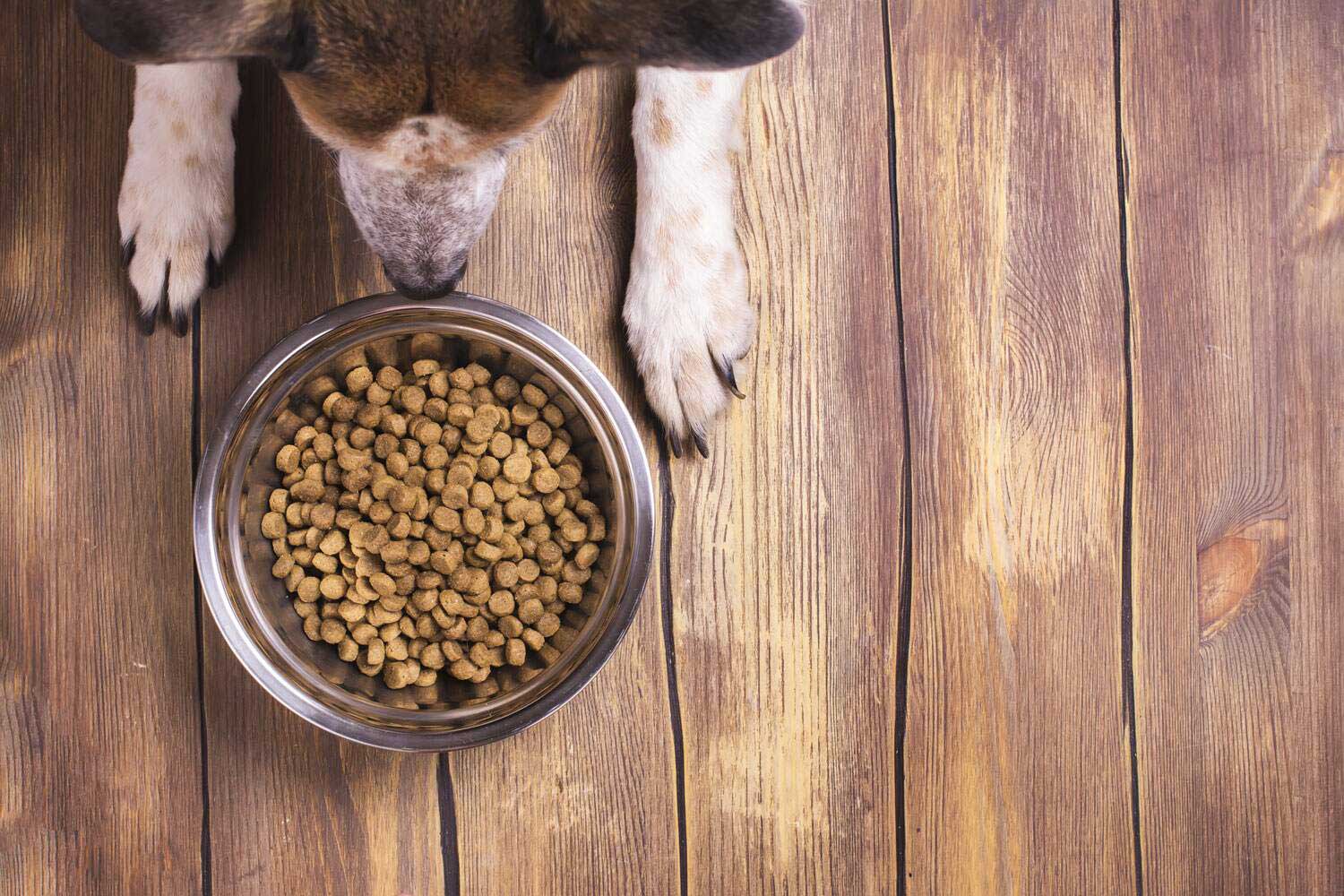
Your dog's diet impacts every aspect of their overall health, and knowing what or how much you should feed your dog isn't as black and white as pet food labels suggest.
Between snacks and table scraps, we love our pets and often want to share. However, your dog's health relies heavily on their diet and eating dog food. Feeding your dog is a science where you put your pet's nutritional needs first.
This article will tackle the big question, "How much should I feed my dog?" How much food you feed your pup will depend on the dog's weight and age. A dog feeding chart can give you an idea of how much food to feed, but all brands are different, so be sure to check the label on the dog food.
If you have a young pup, you'll want to forego dog food and only feed puppy food. However, if your doggo is in their prime, then you'll want to feed a quality adult dog food.
Keeping Your Dog Healthy and Fit
Maintaining your dog's weight, muscle mass, and energy levels contributes to his overall well-being, which drives home the importance of feeding your dog a premium diet.
Quality is important, and you should take a serious look at your pet's food and decide if they are getting the right balance of digestible nutrients from their diet.
Obesity in dogs has been proven to shorten a dog's lifespan and reduce their quality of life. Extra weight problems can lead to serious health concerns like diabetes, pancreatitis, and a number of potentially debilitating mobility issues.
If you find yourself asking, how can my dog lose unwanted pounds? A well-researched weight loss plan can give your pup the nutrition they need to live a long, happy life, and you won't have to wonder, is my dog fat or how much food should I feed.
How Much Food Do Adult Dogs Need?
Diet and exercise are the best ways to prevent obesity, but even the healthiest diets and lifestyles can fail if you are over or under-feeding your dog.
How much you feed your dog isn't always easy to master, but if you can understand what your canine needs with a dog feeding guide, you can help support their body during the growth and maintenance stages.
The amount of food adult dogs need varies based on factors like their size, activity level, and age, but a general guideline is to feed them 1 to 2 cups of high-quality dog food per day, divided into two meals.
Your dog's eating habits can also affect how well they use the nutrients they eat. You might find out that you are feeding the right portions, but your dog prefers to scarf down his food in record time. Instead of changing the feeding guidelines, you may need to consider alternative feeding methods like slow-feed bowls of food puzzle toys.
Are My Dogs Overweight?
The Association for Pet Obesity Prevention estimates that 54% of dogs in the U.S. are overweight or obese. That means if you're not sure, your dog has a 1 in 2 chance of being outside it's optimal weight range. According to recent studies, adult dogs which are kept at their ideal body weight live 1.8 years longer.
Is My Dog Fat?
Not everyone is a pet nutritionist, a vet, or an expert on pet health issues. A simple inspection using touch, sight and a general awareness of how your dog acts should give you enough information to determine whether or not your little (or big) friend needs to lose a few pounds.
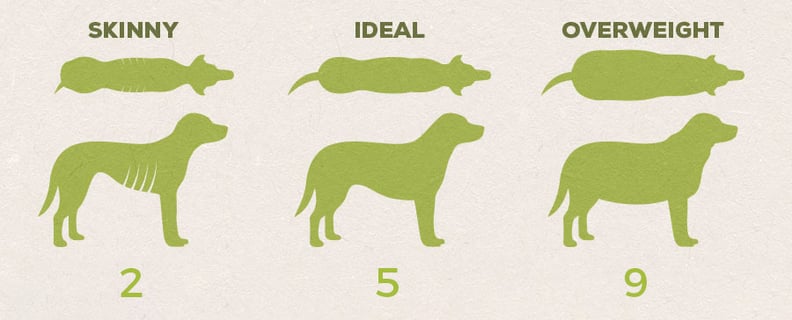
How to Tell If My Dog is Overweight
Sight Test
Dogs have a certain shape, and for the most part, that isn't reminiscent of a barrel. Take a look at your dog in profile – look for folds around the neck or obvious fat deposits at the base of the neck.
Next, check from above. If your dog is getting a little extra mass, it will likely settle between its hips and rib cage, giving your dog that unwanted ‘barrel' look.
Instead, your dog should have a discernible waist between the end of her ribs and the beginning of her hips. Now, step back and make sure the tummy tucks upwards after the ribs.
Puppies have a cute little tummy, but a full-grown dog should have a more svelte look. Toy dogs or other small breed dogs are often very diminutive.
Touch Test
Your dog loves to be touched, whether it's a loving pet, a scratch behind her ears, or a simple pat on his head. And chances are, good pet owner that you are, you spend a portion of the day giving your dog the attention she desires.
So, next time you pet your dog, pay attention to what you're feeling. Give his side a bit of a scratch and see if you can feel your dog's ribs there or if there's a layer of fat between your fingers and the rib cage.
Give her a little belly rub and watch how much jiggle there is down there. Finally, end off with a good neck scratch – see if you can get that back leg going.
Are there folds of flesh (of course, if your dog is a sharpei or a bulldog…) and fat hanging around the neck, or rolling over the collar? Some breeds are naturally rolly and or polly, so the touch test isn't foolproof. We recommend familiarizing yourself with your breed's natural shape to be able to tell if he's out of it.
Stamina Test/Condition
A healthy dog should be able to move around with ease. This ease has a lot to do with your dog breed and goes from Bulldog to Collie. But, within reason, your dog should be able to keep up with you.
If he's always panting and out of breath and doesn't have the stamina you remember him having, it could be because he's packing around extra weight than he used to.
Again, breed matters. Some large breed dogs and short-nosed dogs always breathe a little heavier and aren't meant for marathons and sprinting, especially Brachycephalic breeds, like pugs, that have short snouts.
Check out his gait as well. If his legs are bowing out (and he's not a bulldog or other bow-legged breed), it could be a sign of obesity or a hip and joint issue caused by excess weight. Excessive weight can impact the dog's health.
In addition to the above tests, the Dog Breed Weight Chart below can help you determine how heavy should my dog be and whether or not they are in a safe range for their breed.

Dog Breed Weight Chart
Do you suspect your dog is a little rounder than he’s supposed to be? Find out how he stacks up against his breed standards. Choose your breed and gender and we’ll give you your dog breeds ideal weight.
Every dog is different, and when it comes to cross breeds and mixes, your dog may not fit the typical body type of his breed(s). This calculator offers a general standard, but may not take into account your dog’s unique characteristics and breeding.
How to Feed For Your Dog's Life Stage
Once you've established your dog's perfect weight, the next step is to consider the ideal guidelines to feed for your dog's life stage. You'll feed an adult dog healthy foods for energy, but you might want to cut back the calories for senior dogs.
Giant breed dogs will also require a different protocol because they age faster than small ones.
Your pup's age can greatly impact their feeding requirements, activity level, eating habits, and overall health condition. It can be confusing when we see so many “all life stage” foods on the market.
It gives us the impression that most adult dogs have the same requirements, metabolism, digestion etc. A dog feeding chart will give you a general idea of how much to feed.
Here's a basic breakdown of the factors that may affect the feeding requirements for growth, maintenance, and senior life stages:
Puppies

The first 2 years of your dog's life can affect the quality of the rest of their life. This is called the growth stage. During this period, your dog will continue to grow and develop all of their body's systems. Most pups will need nutritious puppy food.
Remember, do not feed your puppy adult dog food. Your pup needs pet food developed for their life stage. A puppy feeding chart provides you with the needed information on how much to feed.
This growth period uses a lot of energy and nutrients; therefore, the feeding guidelines are higher than those of an adult or a senior dog. Look at the feeding chart on the dog's food label to determine how much puppy food you should feed.
During their puppy stage, their calorie and energy requirements will change as they grow. It's important to monitor weight and muscle gain to ensure that they develop appropriately and keep an eye on the puppy feeding chart. You might have to change puppy food brands as your dog's needs evolve.
If you're wondering how much food a day for a puppy is right, you've come to the right place. Most puppy feeding instructions are based simply on weight, which will frequently change in the first 9-12 months, but that is not the only thing to consider. You'll want to use quality puppy food.
Puppies under 4-6 months of age may require more calories from protein, fat, and carbs to maintain even growth. At this time, their bodies could be tripling in size, more for larger breeds, and many of their vital systems and cognitive functions require a lot of energy to develop properly.
Develop a Puppy Feeding Schedule
Feed puppies different food choices slowly to make the pup's system accustomed to different food choices.
Examine the dog food package using the dog feeding chart to determine how much to feed. Remember, dog feeding amounts vary based on the type of food, puppy age, and breed.
After 6 months, food intake may need to taper off as growth spurts will start to come in more regular cycles. They will gain weight and then thin out as their skeletal and muscle structure develops. This is very normal, but you should always monitor your pet's growth, as it can indicate if you are either over or under-feeding.
During these developmental stages, weight gain can add unnecessary strain to your pet's joints and connective tissues. Keep a sharp eye on the brand's feeding chart and on your dog's overall size. Remember, puppies eat more to meet the needs of their growing bodies.
Avoid mobility issues in the future by adjusting your pup's feeding schedule appropriately as they grow and exercising them through walks and trips to the dog park. Your puppy should be started on puppy food right after being weaned from mother's milk. Remember, puppies eat a lot.
Adults
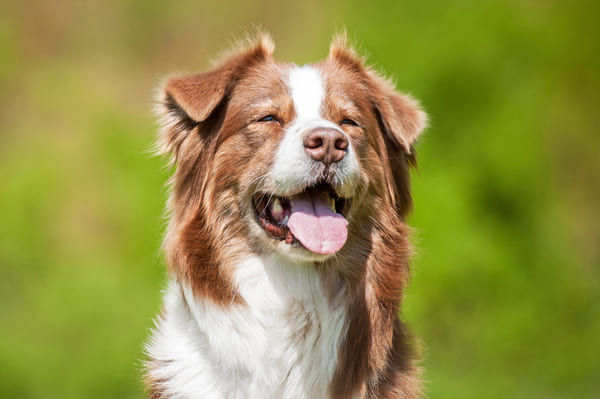
Once your dog is over 2 years old, with the exception of some large and giant breeds, they will be done growing. This is not to say that they won't continue building muscle mass, but their skeletal structure and base muscle form will fully develop.
For smaller breeds, growth can be complete as early as 12-18 months. Always consult the dog feeding charts.
In the adult stage, your dog's diet should help maintain a healthy weight and activity level. Feeding instructions for adult dogs are not as high as for a puppy, and it's a lot easier to overfeed if you are not careful.
Most dogs who are active can eat more than inactive or elderly pooches. You can even free-feed an active dog, but you'll want to avoid the practice with less active dogs. Especially if the dog shows signs of gaining weight or the dog's body condition starts to show signs of unwanted fat.
Most dog feeding charts are tailored to the average adult doggo, of average activity level and average metabolism. The plan will help you maintain a consistent feeding schedule or once-a-day meals to meet your dog's nutritional requirements. You won't have to wonder how much to feed.
While dog feeding charts make sense, they might not be perfectly accurate for your dog's needs. Many young and older puppies will require more frequent meals to maintain their current weight and healthy lives. So you'll still be left wondering how much to feed.
Some breeds will do well free feeding, but others must be kept on a very stringent feeding schedule. Check the dog's food packaging when making a decision. Often learning how much to feed is a trial-and-error process.
Senior
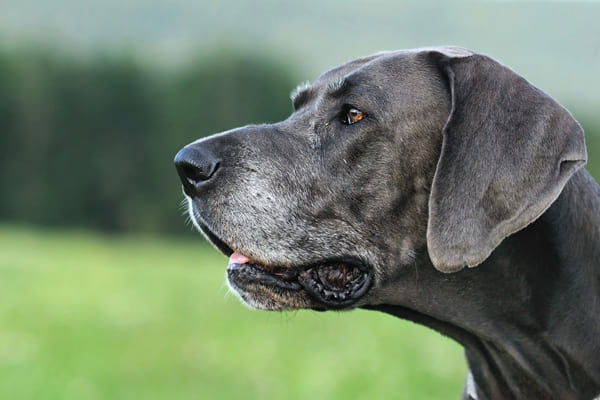
Weight issues among senior dogs can be a very serious issue. Both over and underweight senior dogs may lead to shorter and less comfortable later years.
Maintenance of muscle mass, skeletal structure, and digestion are the biggest concerns for most senior pets, so choosing food that matches their needs is important.
Different breeds reach their senior stage at different times. Small and medium breeds often don't show signs of age-related decline until after 7-9 years old, while large and giant breeds may be considered seniors as early as 5.
Look for signs of aging to indicate whether you should be adjusting your diet and feeding protocol to match your dog's life stage. Most dogs will start showing signs of failing health, such as leaving food. or show a decline in appetite.
Feeding instructions for senior dogs may decrease as their energy levels, mobility, and appetite diminish. You'll need to make adjustments to meet your dog's needs and perhaps provide more calories if needed. Some seniors do best with free-feeding if they are struggling with weight loss.
Dog Food Calorie Calculator
Determining feeding guidelines first requires you to understand your dog's caloric intake. Once you know how many calories adult dogs eat to thrive, you can determine how much food should a dog eat per day.
When using our dog food calculator, always put in your dog's ideal weight. This calculator is best used for dogs that are fed kibble or canned food diets.
Always factor in the dog's lifestyle if you are dry food feeding or using wet. A dog's breed is also important. Clearly, toy breeds will not eat as much as large breeds.

Dog Food Calorie Calculator
Are you feeding your dog too many calories? Find out how many calories your dog needs to stay healthy and fit. Just enter your dog's ideal weight and select the appropriate life stage.
Feeding Guidelines
The calculator above will tell you how many calories your dog should have per day, but every food will offer different calories, so the feeding guidelines will vary depending on the formula.
Once you know your dog's calorie requirements, you can look at your dog's food and figure out how many cups or grams of food will provide those calories.
Near the guaranteed analysis or ingredient panel of your dog's food, a small section should tell you how many Kcals/kg and how many Kcals/cup are in that formula.
Take your total calorie target for the day, and divide it by the number of Kcals/cup to get a closer estimation of how much you should be feeding per day.
To give you an example, an average 50lbs. adult dog will need about 1150 calories per day. If his food offers 419Kcals/cup, then his daily feeding recommendation would be about 2 3/4 cups per day.
Small breeds will consume less. Follow the food's recommendations for the adult dog size when feeding.
Making Adjustments for Your Dog Size
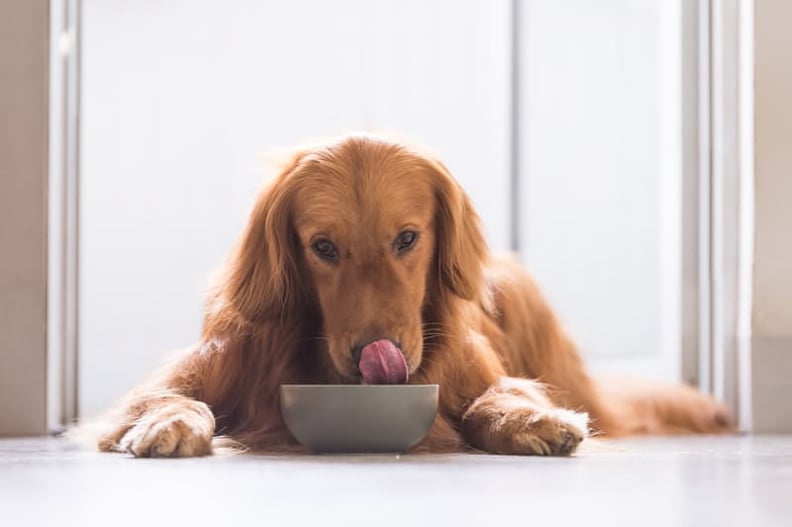
Now that you've determined how much I should feed my dog, you may want to start adjusting to your current feeding routine. Bigger changes should be done gradually to help your pet adjust.
If your dog is at an ideal weight and size, and you are looking to maintain, then keep doing what you're doing unless you notice physical or behavioural changes.
Adjustments can be made to their treat routines as well. If you are looking to slim down your pet a little bit, then maybe cutting back on treats can help, and is also a great way to increase caloric intake for dogs needing to gain a little bit of weight.
Use treats made from wholesome ingredients to supplement their diet when wondering how much I should I feed.
For dogs that participate in sporting activities, hunting, and even just seasonal changes to their activity levels, their feeding instructions may need to be adjusted on the fly.
If you are wondering if your pup might have a weight problem as it ages, then look at the dog's same-sex parent to get an idea of adult size. Then you can better gauge weight and food intake. Dogs tend to follow in the paw prints of their parents.
This may mean that on high activity days, portions are increased, and on low activity days, they are proportionately reduced. This is definitely not a great method for beginners, as some trial and error is involved. If you have a working dog, it may be useful for maintaining weight.
Frequently Asked Questions About Dog Feeding
How much food should a dog eat?
The appropriate amount of food depends on factors like your dog's age, breed, size, activity level, and metabolism. Consult the feeding instructions on the dog food packaging.
What is the recommended feeding schedule for dogs?
Many dog owners choose to feed their dogs twice a day – once in the morning and once in the evening.
What health risks are associated with an overweight dog?
Overweight dogs are at a higher risk of developing various health issues, including joint problems, diabetes, heart disease, and reduced overall quality of life. Maintaining a healthy weight is crucial for your dog's well-being.
How can I help my overweight dog lose weight?
Consult your veterinarian for a plan to lose weight that is tailored to your dog's needs. This may involve adjusting their diet and portion sizes and increasing exercise gradually.
Can I switch my dog to weight management or low-calorie dog food?
Yes, weight management or low-calorie dog foods can be beneficial for dogs needing to shed extra pounds. However, choosing a high-quality brand that still provides essential nutrients is important.
Is it possible to overfeed my dog even with high-quality food?
Yes, overfeeding can occur even with nutritious food. It's important to measure portions accurately and avoid giving too many treats or table scraps, as these can contribute to excess calorie intake.
.png?width=200&height=66&name=logo%20(1).png)




.jpg)
